May 18, 2025 | 02:31 GMT +7
May 18, 2025 | 02:31 GMT +7
Hotline: 0913.378.918
May 18, 2025 | 02:31 GMT +7
Hotline: 0913.378.918

Architectural area in Tu Buoi Pottery Village was built in 80% of red brick. Photo: Kim Anh.
The Tu Buoi Pottery Village was established by artisan Mr. Nguyen Van Buoi (affectionately known as Mr. Tu Buoi), who is nearly 70 years old and resides in Ward 5, Vinh Long City. Coming from a family with a long-standing tradition of making red pottery, he has been dedicated to the craft for almost 40 years, always nurturing the dream of restoring the prosperity of the ancestral craft village.
With a highly creative idea, he spent over 3 years planning the development of a tourist destination featuring architecture entirely made from red pottery. This project demonstrated that pottery is not only used for making flower vases, bricks, or tiles but can also be used to create unique architectural structures.
Continuing the family tradition, Mr. Huynh Tan Dat, Mr. Tu Buoi's son, who had lived and worked abroad for 35 years, decided to bring modern Western experiences and thinking to develop the tourism model in a professional direction, while still preserving the soul of the traditional craft village.
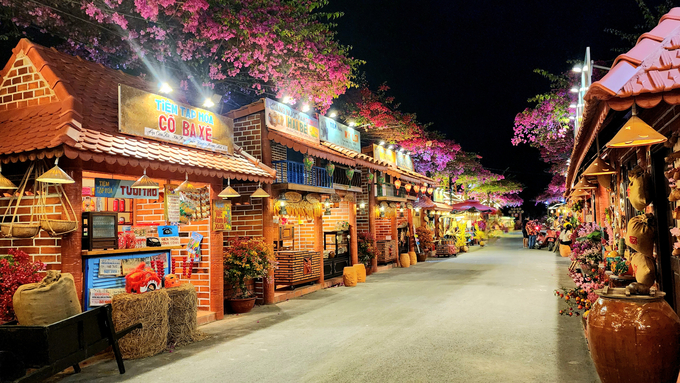
Tu Buoi pottery village at night is brilliant with its architectural space that blends traditional and modern elements. Photo: Kim Anh.
The pottery village, covering an area of 10,000m², will officially open to visitors at the end of 2024. One of the most striking features of the pottery village is that 80% of the construction materials used are made from red pottery, including columns, tiled roofs, household items, and decorations - all produced by the facility itself. The project not only brings aesthetic value but also showcases the unlimited creativity of pottery artisans.
Visitors to the village will have the opportunity to witness the traditional pottery-making process firsthand, from kneading clay, shaping, drying, to firing the finished products. Additionally, tourists can create simple pottery products with the guidance of skilled artisans.
There will also be a culinary street offering traditional cakes, a restaurant serving specialties from the Mekong Delta, performances of don ca tai tu (traditional Southern music), and a bonsai nursery.
This tourist destination operates in a multi-layered fashion, combining modern elements with the traditional values of the homeland. The entire space is covered with the red color of pottery, complemented by the pink hue of giant bougainvillea pots. The pottery-making area is decorated and designed in the style of ancient Southern Vietnam.

Thanks to the close connection between production facilities, the red ceramic industry in Vinh Long has enough large production capacity to meet orders from domestic and foreign markets. Photo: Kim Anh.
In addition to tourism development, the pottery village also plays an important role in the production and supply of red pottery products. Customers wishing to design houses using red pottery will be consulted from the idea phase, drawing, and construction.
Moreover, the pottery village accepts bulk orders to produce pots, decorative items, and more to serve both the domestic market and export. Currently, the facility is providing stable employment and income for around 20 local workers and seasonal laborers, with salaries ranging from VND 6 to 25 million per month.
According to Ms. Vo Le Dieu Phuong, Vice President of the Vinh Long Ceramic and Pottery Association, red pottery from Vinh Long has been around since the 1980s. However, it was only a few years ago that this product became more widely known to the public and tourists, thanks to the efforts of artisans and production facilities.
The red pottery brand of Vinh Long has gradually established its position in the market as local facilities began receiving export orders, with key products such as decorative animals, pots, vases, stools, tables, columns, beams, roof tiles, and more.
Currently, there are about 50 production facilities in Vinh Long under the Vinh Long Ceramic and Pottery Association, and around 200 brick kilns along the Co Chien River.
One of the major challenges for the pottery village is the clay supply. Vinh Long does not have its own clay mine, so the facilities must import clay from neighboring provinces like Tra Vinh and Ben Tre. The clay is typically taken from high fields that need leveling, then pressed into blocks called "dat me" (đất mê) before being processed.
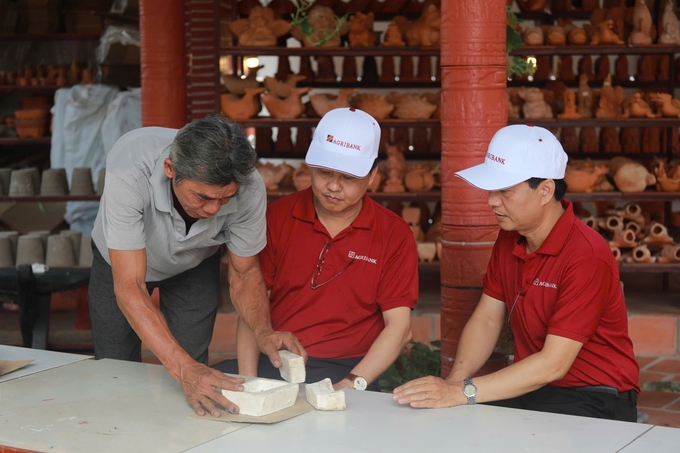
Visitors experience the production process of ceramic handicrafts at Tu Buoi Pottery Village. Photo: Kim Anh.
The pottery production process involves several meticulous steps: the clay must be kneaded with water and sometimes mixed with chemicals to ensure smoothness, then dried and fired in the kiln, and finally allowed to cool for about half a month before being ready for use.
Despite these challenges, thanks to the strong cooperation between production facilities, the red pottery industry here still maintains a large production capacity, ready to fulfill any orders from both domestic and international markets.
Not just a new tourist attraction, Tu Buoi Pottery Village is also a key part of the effort to restore and develop Vinh Long's red pottery trade. By blending tradition and modernity, it not only preserves cultural values but also opens up commercial opportunities, helping to expand the reach of Vinh Long’s red pottery in both the domestic and international markets.
In the future, when phase 2 is completed, Tu Buoi Pottery Village will add more new structures, becoming a unique cultural-tourism-creative center, contributing to making red pottery a source of pride for Vinh Long.
Translated by Kieu Chi
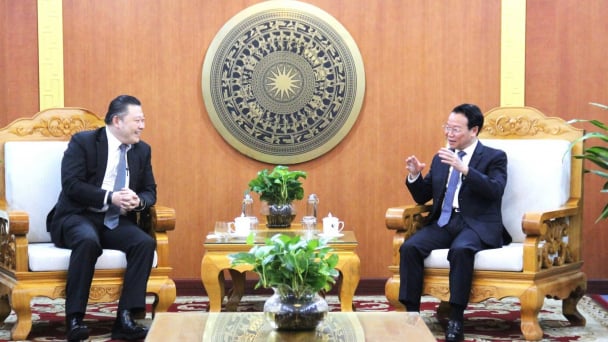
(VAN) Minister of Agriculture and Environment Do Duc Duy held a meeting with Soopakij Chearavanont, Chairman of C.P. Group, on May 15.
/2025/05/16/3800-0-nongnghiep-143756.jpg)
(VAN) Suntory PepsiCo Vietnam coordinated with the Ministry of Education and Training to implement an education program on water conservation, reaching nearly 1 million primary school students nationwide.
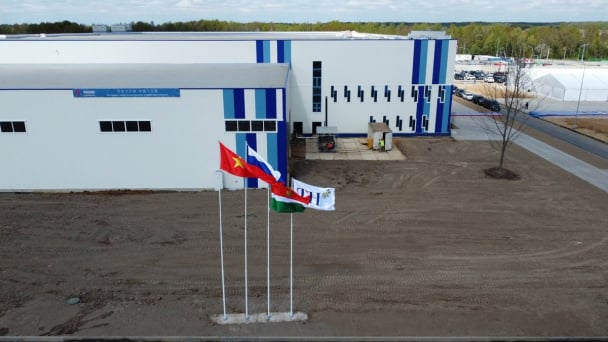
(VAN) Vietnam’s TH Group officially put its high-tech fresh milk processing plant into operation in the Russian Federation, marking a historic moment as the first TH true MILK cartons were produced in Russia.

(VAN) Use of high-quality broodstock and biotechnology is regarded as the most effective approach to ensuring sustainable and economically viable shrimp aquaculture ahead of climate change and the emergence of increasingly intricate disease patterns.

(VAN) Carbon farming is a form of agricultural practices that helps absorb more greenhouse gases than it emits, through smart management of soil, crops, and livestock.
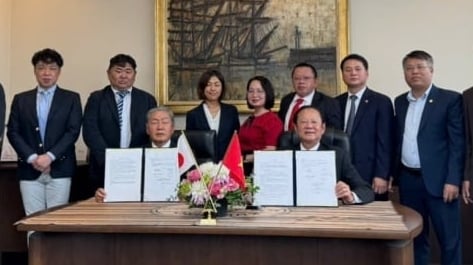
(VAN) This is a key content of the Memorandum of Understanding recently signed between the Vietnam Fisheries Society and Kunihiro Inc of Japan.
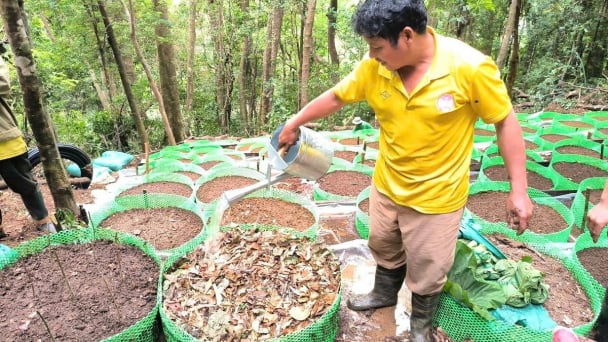
(VAN) To achieve the goal, local authorities and businesses in Kon Tum province have fully prepared the necessary conditions for the new Ngoc Linh ginseng planting season.